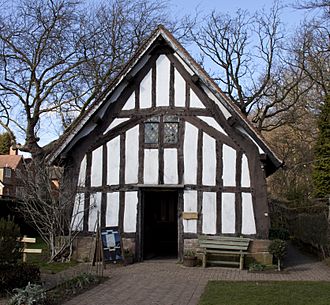Minworth Greaves facts for kids
Quick facts for kids Minworth Greaves |
|
|---|---|

Minworth Greaves
|
|
| General information | |
| Type | Medieval hall house |
| Address | Maple Road, Bournville |
| Town or city | Birmingham |
| Country | England |
| Coordinates | 52°25′51″N 1°56′03″W / 52.43077°N 1.93426°W |
| Construction started | 14th century or before |
| Renovated | 1929-32 |
| Technical details | |
| Structural system | Cruck-frame |
| Designations | Grade II listed |
| Renovating team | |
| Architect | William Alexander Harvey |
Minworth Greaves is a very old timber-framed building in Bournville, Birmingham, England. It is a special type of building called a cruck-framed house. Experts think it was built around the 14th century, or even earlier, possibly as far back as 1250.
This historic building is owned by the Bournville Village Trust. Today, Minworth Greaves is located right next to Selly Manor. It is part of the Selly Manor Museum, where people can visit and learn about its past. The building was not always in Bournville. It was originally built in a place called Minworth, near Sutton Coldfield. After it became very old and damaged, George Cadbury bought it. His son, Laurence Cadbury, had it carefully taken apart and rebuilt in Bournville in 1932.
What is Minworth Greaves?
Minworth Greaves is a building made with a special method called timber framing. This means its main structure is built from large wooden beams. The spaces between these beams are filled with plaster.
The oldest part of the building is a two-bay hall. It uses a unique building style called cruck-frame. Imagine a huge oak tree bent into an arch. This tree was split in half lengthwise. These two halves were then used to form the main roof supports. This creates a strong and impressive structure.
Today, there's also a newer part of the building. It has a gallery, which is like a long balcony inside. Long ago, the original windows were different. They were smaller and placed higher up. Instead of glass, they used cloth soaked in animal fat to let in light.
Moving a Historic House
Minworth Greaves did not start its life in Bournville. It was first built in Minworth, a village north of Birmingham. Over many years, the building became very old and damaged. Only the main wooden frame was left standing.
In 1932, George Cadbury bought the old building. His son, Laurence Cadbury, then arranged for it to be moved and rebuilt. This happened in the grounds of Selly Manor. Selly Manor itself had also been moved and rebuilt by the Cadbury family by 1916.
When Minworth Greaves was rebuilt, only the strong cruck-beamed great hall and some of the main timbers could be saved. These pieces were put back together. The goal was to show what a cruck-beamed hall would have looked like long ago. An architect named William Alexander Harvey was in charge of this big rebuilding project.
A Special Table and Museum Life
In 1921, a very large oak table was brought to Minworth Greaves. This table is 18 feet (about 5.5 meters) long and has eight legs! It was made in 1630. The table came from a place called Crook Hall in Lancashire, which no longer exists.
The table has a special message carved into it: 'an arelome to this house forever. P.C.'. This means it was meant to stay with the house always.
Minworth Greaves was recognized as a Grade II listed building in 1952. This means it is a very important historic building that needs to be protected. Today, Minworth Greaves is open to the public. It is used to host different exhibitions, allowing visitors to step back in time and learn about medieval life.

